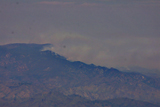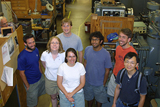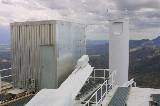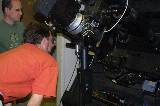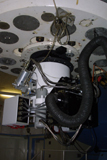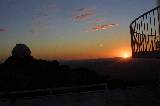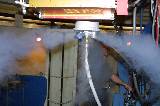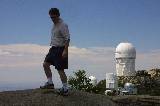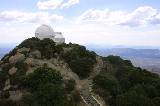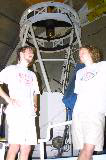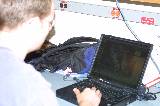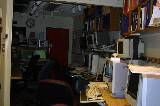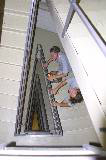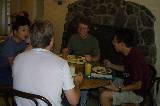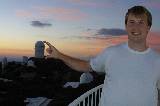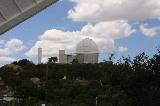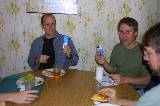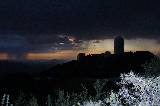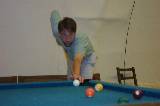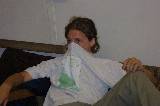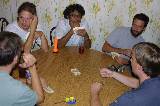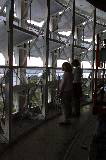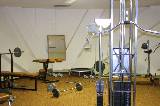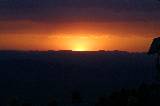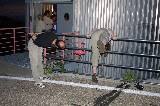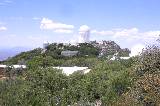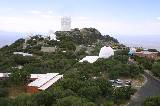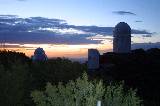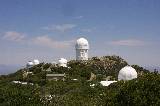 |
 |
|||||||
U. Maryland Astronomy - Kitt Peak
|
||||||||
|
Exposure time: 1/350s
Aperture: 95.0 Focal length: 90.0mm Caption: Proposals
|
In 2003, the UM Astronomy Department became part of the UM-NOAO* collaboration at Kitt Peak National Observatory near Tucson, AZ. This new partnership gives department faculty and students designated time on certain telescopes at Kitt Peak. It was no longer feasible to do high quality observational research locally (College Park, MD) because of the light pollution and general weather -- we are at the bottom of the atmospheric soup! Instead, the campus observatory is used to teach undergraduates and for public outreach. In addition, to build a new facility is also very expensive especially when excellent facilities like Kitt Peak exist. This summer, the department decided to have a "summer school" to give some of the grad students experience in writing observing proposals and to 'train' them on some of the instruments and telescopes available at Kitt Peak. Because of my duties with the Deep Impact mission and as the campus Observatory director, I was able to go along, even though I'm not a grad student.
|
Exposure time: 1/250s
Aperture: 95.0 Focal length: 35.0mm Caption: |
||||||
7 JulyMost of us flew out of the DC area on 7 July. I was the first one out at 6:30am out of BWI. Of course, the plane didn't leave on time -- I got a free headphone out of it. Just barely made my connection in Houston. I like window seats cause I like to watch. As we flew westward from Houston, the scenery changed from luscious green to desert. As we passed El Paso (?), I noticed that the air had gotten extremely hazy. Shortly afterwards, the reason became apparent as a mountain in the distance appeared. Now I couldn't see the fires, but I doubt that is fog coming off the mountain! Before we get too far, let's introduce our little tour group: |
Exposure time: 1/750s
Aperture: 13.0 Focal length: 135.0mm Caption: Can you find the Large Binocular Telescope Observatory? |
|||||||
|
||||||||
|
Exposure time: 1/60s
Aperture: 4.0 Focal length: 28.0mm Caption: Rob, Misty, Matthew, Elizabeth, Rahul, Dave, Ke |
8 JulyNot everyone arrived yesterday. There were some flight delays and cancellations, so some got in really late and others would arrive later in the day. In the meantime, those of us who were there, elected Dave (newly minted PhD!) as leader and headed over to the NOAO offices for a tour of their facility. After the tour, it was time to pack the cars and head up to Kitt Peak. We weren't sure when lunch ended, but we were determined to get there in time! |
Exposure time: 1/180s
Aperture: 8.0 Focal length: 41.0mm Caption: And where are we going to fit? |
||||||
|
Exposure time: 1/350s
Aperture: 9.5 Focal length: 80.0mm Caption: |
Once we finished eating (someone, please feed these grad students!), we had a little time to ourselves (to unpack, sleep, whatever) before we had to meet at our respective posts to learn how to set up the telescopes/instruments.
|
|||||||
The first night (night 1, 8/9 July), I was assigned to the Coudé Feed. Although located in the 2.1-m building, it was not in fact being 'fed' from the 2.1-m telescope (although it can be). Imagine a giant optics table but spread through two rooms... we could walk between the optical components of the instrument. That was neat! |
||||||||
|
Exposure time: 1/500s
Aperture: 13.0 Focal length: 28.0mm Caption: The silver shed rolls back to reveal the primary for the coudé feed. Light reflects from that mirror to a mirror in the tower (closed) which then reflects the light down a tube (thing that looks like a gun cannon). |
Exposure time: 1/60s
Aperture: 4.0 Focal length: 28.0mm Caption: The light that comes down the tube enters the building and reflects off of a mirror (behind Dave) and through the slit, which Dave is inspecting. |
Exposure time: 1/60s
Aperture: 4.0 Focal length: 28.0mm Caption: After passing through the slit, the light goes into another room, where it goes through the grating and on through more optics before reaching the camera. Here Dave is checking out the camera. |
Exposure time: 1/250s
Aperture: 8.0 Focal length: 135.0mm Caption: Infestations of ladybugs in the coudé feed primary shed. |
|||||
|
Exposure time: 1/500s
Aperture: 11.0 Focal length: 60.0mm Caption: Night 1 does not bode well at this point right after dinner! But the rainbow was pretty! |
Exposure time: 1/60s
Aperture: 3.5 Focal length: 28.0mm Caption: SQIID |
Exposure time: 1/60s
Aperture: 4.0 Focal length: 28.0mm Caption: Listening in on the 2.1-m discussions. |
Exposure time: 1/250s
Aperture: 9.5 Focal length: 28.0mm Caption: Sunset! And we actually get to observe tonight! |
|||||
9 JulyCalled it a night sometime between 1-2am, but I stayed up until about 4am reading... wanted to get into the groove of being up all night and sleep through the day. Unlike the grad students, I still had trouble sleeping late! So I got up and took shots of the area. After lunch, we also got a tour of the WIYN 3.5-m telescope -- that really is a neat dome. Afterwards, a few of us took an 'unofficial' tour of the 4-m Mayall telescope. That would be a great place for a game of hide-and-seek! Another gorgeous sunset and then an amazing night -- we observed all night! |
||||||||
|
Exposure time: 1/350s
Aperture: 11.0 Focal length: 50.0mm Caption: The dorms for visiting observers are very comfortable. Unfortunately, the day tourists didn't always heed the signs. |
Exposure time: 1/350s
Aperture: 13.0 Focal length: 28.0mm Caption: Back in 1994, I visited Kitt Peak with my parents. This is a re-make of a photo that we took back then! |
Exposure time: 1/60s
Aperture: 4.0 Focal length: 28.0mm Caption: Refilling the dewar on the 0.9-m until it 'steams' out. Actually that is some of the liquid nitrogen starting to sputter out. The nitrogen is clear but very cold so that where it mixes with the air, it chills the air creating a 'fog.' |
Exposure time: 1/750s
Aperture: 13.0 Focal length: 56.0mm Caption: King of the hill?? |
|||||
|
Exposure time: 1/90s
Aperture: 6.7 Focal length: 28.0mm Caption: in front of the actuators for the WIYN mirror (back of telescope). |
Exposure time: 1/90s
Aperture: 5.6 Focal length: 28.0mm Caption: In front of the WIYN telescope. |
Exposure time: 1/350s
Aperture: 11.0 Focal length: 70.0mm Caption: I love to take pictures, but I was a little 'shy' at first, so I was only taking real basic pictures, but then I warmed up and started looking for artistic and fun shots as well the pictures to document the trip! (Kevin) |
Exposure time: 1/500s
Aperture: 13.0 Focal length: 100.0mm Caption: Fun with perspectives! Or... Good little telescope! (Rob) |
|||||
|
Exposure time: 1/350s
Aperture: 13.0 Focal length: 28.0mm Caption: When the weather was nice, we would check out the view from the 2.1-m catwalk. Here, looking west towards the 0.9-m and WIYN telescopes. |
Exposure time: 1/350s
Aperture: 8.0 Focal length: 135.0mm Caption: Rahul and Sylvain finally make it back from the WIYN tour. |
Exposure time: 1/60s
Aperture: 4.0 Focal length: 28.0mm Caption: Dave and Kevin chat by the 2.1-m. |
Exposure time: 1/60s
Aperture: 4.0 Focal length: 28.0mm Caption: Ke gets ready to observe (actually he's checking his email!). |
|||||
|
Exposure time: 1/60s
Aperture: 4.0 Focal length: 44.0mm Caption: Rob checks the weather... Will we or won't we open tonight?? |
Exposure time: 1/60s
Aperture: 4.0 Focal length: 33.0mm Caption: Matthew studies in his room. |
Exposure time: 1/500s
Aperture: 13.0 Focal length: 28.0mm Caption: Jianyang (Looking south from the 4-m Mayall telescope, as you can see, there are lots of telescopes on this ridge!) |
Exposure time: 1/60s
Aperture: 4.0 Focal length: 28.0mm Caption: 4-m control room |
|||||
|
Exposure time: 1/60s
Aperture: 3.5 Focal length: 28.0mm Caption: One way to get your exercise -- run up and down the stairs in the 4-m building! |
Exposure time: 1/60s
Aperture: 4.0 Focal length: 28.0mm Caption: Dinner! |
Exposure time: 1/350s
Aperture: 13.0 Focal length: 28.0mm Caption: Jianyang and Ke on the 2.1-m catwalk. Despite, the clouds in the afternoon, the night was clear. |
Exposure time: 1/180s
Aperture: 6.7 Focal length: 95.0mm Caption: Near sunset, the 0.9-m and WIYN domes open their vents. |
|||||
|
Exposure time: 1/125s
Aperture: 6.7 Focal length: 44.0mm Caption: Note the shadow of the 4-m Mayall on the McMath (solar) Observatory. |
Exposure time: 1/180s
Aperture: 9.5 Focal length: 28.0mm Caption: Sunset! |
Exposure time: 1/60s
Aperture: 5.6 Focal length: 28.0mm Caption: Fun with perspectives! Or... The 4-m Mayall is this big! (Matthew) |
Exposure time: 1/60s
Aperture: 4.0 Focal length: 28.0mm Caption: Rob and Rob at the 2.1-m controls. |
|||||
10 JulyTwo beautiful sunsets and now a sunrise! Actually it wasn't as pretty as the sunsets, maybe because I was starting to fall asleep at the camera! But I did get some shots of Venus rising. After lunch, some of us walked over to the McMath Solar Telescope and checked it out, but there was no one on hand to give us a behind the scenes tour. The afternoon was filled with thunderstorms which did not bode well for the evening. Watched another nice sunset, nearly stepped on a rattlesnake, and took some okay lightning shots. The storm was too far away. We ended up hanging out in the quonset watching movies, playing pool, and basically goofing off before it was determined (around 3am) that there was not a chance of observing tonight! So we got some sleep. |
||||||||
|
Exposure time: 1/500s
Aperture: 13.0 Focal length: 60.0mm Caption: Beneath the McMath telescope looking west to the 2.1-m dome. |
Exposure time: 1/60s
Aperture: 4.0 Focal length: 28.0mm Caption: Cheers! We really liked the icecream sandwiches! (Sylvain and Stacy) |
Exposure time: 1/60s
Aperture: 4.0 Focal length: 28.0mm Caption: Where's my midnight lunch? (Sylvain and Stacy) |
Exposure time: 1/60s
Aperture: 4.0 Focal length: 28.0mm Caption: No observing tonight. |
|||||
|
Exposure time: 1/60s
Aperture: 4.5 Focal length: 50.0mm Caption: Although it was cloudy, we couldn't just go to bed because it might clear off later. So we had to amuse ourselves. The resident telescope operators were watching a movie that the 'kids' weren't interested in, so we headed over to the quonset to watch our own movie, play pool,... |
Exposure time: 1/60s
Aperture: 5.6 Focal length: 135.0mm Caption: Good thing I showered this afternoon! |
Exposure time: 1/60s
Aperture: 4.5 Focal length: 60.0mm Caption: I can make that! |
Exposure time: 1/60s
Aperture: 4.0 Focal length: 28.0mm Caption: Let's play cards! |
|||||
11 JulyWell, since we actually got some sleep, we decided to go on a hike, supposedly to some lake. We started out and knew we might be in trouble when it became clear that no one had been on this trail in a very long time. Okay, maybe not all astronomers are outdoorsy types. And hiking by yourself isn't cool (or safe) either. But off we went. The trail was mostly downhill, steep downhill, so that some of us were wondering how we were going to climb back up. Luckily, the trail crossed the main road, so that even though it might be 'longer' it wasn't quite as steep (and maybe we could catch a ride back up?!). We finally reached a point overlooking the second ridge and watched the radio telescope move around. Dave, Kevin and Rahul went a bit further; Misty, Matthew and Rob decided to head back; and Sylvain and I decided to catch up with Dave et al. We caught up just in time to watch them hightailing it back up the trail... another rattlesnake! So we all headed back as well. Sylvain and I took the road and the guys took the trail back through the brush. Got back just in time for dinner -- can't miss our daily dose of icecream sandwiches! After dinner, we got a formal tour of the 4-m. I got to push the little button to open the vent slats! And then another beautiful sunset. And wow, what a storm over Tucson! Although it was clear overhead for us, the storm appeared to be heading our way, so it didn't look like we'd be able to observe tonight either. |
||||||||
|
Exposure time: 1/250s
Aperture: 11.0 Focal length: 28.0mm Caption: Matthew, Kevin and Dave lead the way. |
Exposure time: 1/250s
Aperture: 95.0 Focal length: 28.0mm Caption: Rahul, Misty, Sylvain, Rob and Matthew take a break. |
Exposure time: 1/350s
Aperture: 13.0 Focal length: 28.0mm Caption: As we approached the next ridge of telescopes, we noted that the radio telescope was being moved. |
Exposure time: 1/180s
Aperture: 6.7 Focal length: 80.0mm Caption: Can you find Dave, Rahul and Kevin? HINT: Dave is wearing an orange shirt! |
|||||
|
Exposure time: 1/125s
Aperture: 6.7 Focal length: 28.0mm Caption: Looking out the vents of the 4-m. |
Exposure time: 1/60s
Aperture: 4.5 Focal length: 28.0mm Caption: In front of the 4-m telescope. |
Exposure time: 1/125s
Aperture: 6.7 Focal length: 28.0mm Caption: Stacy |
Exposure time: 1/500s
Aperture: 11.0 Focal length: 135.0mm Caption: That's quite a storm brewing over Tucson. |
|||||
|
Exposure time: 1/30s
Aperture: 3.5 Focal length: 28.0mm Caption: Dave shows us that he can do something other than astronomy. |
Exposure time: 1/45s
Aperture: 3.5 Focal length: 28.0mm Caption: Sylvain and Kevin playing table tennis. |
Exposure time: 1/10s
Aperture: 3.5 Focal length: 35.0mm Caption: The 4-m workout room. |
Exposure time: 1/125s
Aperture: 5.6 Focal length: 28.0mm Caption: Nightly Observing Program participants watch the sunset. |
|||||
|
Exposure time: 1/180s
Aperture: 8.0 Focal length: 85.0mm Caption: Sunset. |
Exposure time: 1/60s
Aperture: 4.0 Focal length: 28.0mm Caption: Don't ask! Sylvain and Misty inspect the pink flamingo at the SARA telescope. |
Exposure time: 1/60s
Aperture: 4.0 Focal length: 47.0mm Caption: Jianyang and Ke work on downloading data from previous nights. |
Exposure time: 10.0s
Aperture: 6.7 Metering mode: 1 Focal length: 135.0mm Caption: Moonrise. It was kinda spooky and weird to see the crescent moon rising behind the clouds over Tucson. |
|||||
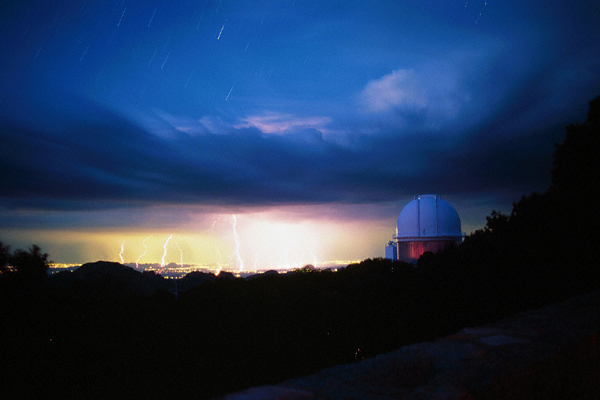 The stars of Cygnus rise above the stormy clouds over Tucson, AZ. Aperture: f/4 Film: Kodak ELITE Chrome 100 Focal length: 28.0mm Camera: Minolta X-700 Caption: Of all the lightning shots that I took over the nights, this one turned out best! Partly because I left it alone! I had to run over to the 2.1-m building for something or other so I left the camera setup by the 0.9-m. I was gone for about 10-15 minutes. In fact, as I headed over to the 2.1-m, I aimed my red flashlight onto the side of the building. At first, I was shocked with myself, but then I realized that no one was observing anyway! In fact, you can see the white dome lights shining out the sides of the slit at the top of the dome! This image was selected as the
If you would like to see my other astrophotos, please visit my website. |
||||||||
12 JulyGot up the last morning a little early to finish packing and make sure I got to the gift shop. I had to get some more of these really cool little necklaces that light up (wish they came in red though! I won't be allowed to wear the blue one at amateur star parties!). After lunch, we headed back to Tucson, dropped off our gear and then headed over to the Steward Observatory Mirror Lab. This is one of the meccas of astronomy. We had heard that it was under the UA football stadium, so must of us were picturing that there was a tunnel that would lead to facilities right under the playing field. In reality, the lab is located under the east stands. And it was a really neat place! But lots of security. |
||||||||
|
Exposure time: 1/60s
Aperture: 4.5 Focal length: 28.0mm Caption: The second 8.4-m LBT mirror undergoing polishing. The first one is already on-site and was threatened by the forest fires. |
Exposure time: 1/60s
Aperture: 4.0 Focal length: 28.0mm Caption: Stacy takes a pic of one of the frames that holds a mirror while they wash out the spacers. |
Exposure time: 1/60s
Aperture: 4.5 Focal length: 28.0mm Caption: One of the honeycomb spacers. |
Exposure time: 1/60s
Aperture: 4.0 Focal length: 30.0mm Caption: Sample of glass showing the hollows left by the spacers. |
|||||
The Daily Pic of the 4-m
Things I learned...
Thank you to...
|
||||||||
JAlbum 4.4
| ||||||||
 Back to Observatory/Gallery/Events
Back to Observatory/Gallery/Events


